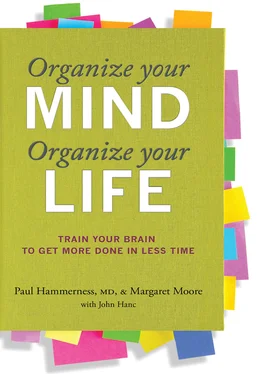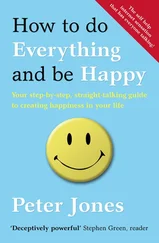One last time, let’s go back to our example of Jill and her keys. In suggesting the idea of the launch pad to this patient, I was actually addressing two of the Rules of Order.
First, because she was emotionally distraught over what her episode with the keys had wrought in her workday, I knew that I had to calm Jill down; to help her Tame the Frenzy (Rule #1). You can’t get organized and can’t make rational decisions about how to get organized when you’re distraught. In her case, the suggestion of the launch pad began a new process of thinking, not only reacting to the problem at hand.
Next, finding the little box that she eventually used for her launch pad and clearing out the space for it at home and in the office helped her to Sustain Attention (Rule #2) on the tasks at hand:
1) putting her keys down and later
2) finding her keys—by removing physical/cognitive distractions
This small success helped Jill become more confident. You can imagine her now starting her morning on a more positive note, heading out the door on time and ready to face the day, as opposed to already demoralized, frustrated and down on herself because of a moment’s inattentiveness.
In the pages ahead we will examine more closely each of the Rules of Order, one at a time, and give you the tools and solutions that can help you to better sustain attention, stay on task and, above all, create a greater sense of order and efficiency in a world that often seems anything but.
Coach Meg and I will provide you with your own launch pad—and then some.
CHAPTER 2
A Change Will Do You Good/Coach Meg
MY COAUTHOR, DR. PAUL HAMMERNESS, does in this book what doctors do wonderfully well at their best—share their expert knowledge and wisdom in a compelling fashion so that you can make the best possible decisions and choices about your health and life. But of course knowledge and insight are only a start. Knowing what to do is one thing; knowing how you’re going to do it is quite another. Doing something means that you need to make some changes, develop some new habits and unlearn some old ones. That’s where I come in.
As a professional coach, change is my business. My kind of coaching has a few things in common with those who coach football or basketball teams. Like the men and women who exemplify the best of that profession, we know how to help people accomplish their best. But our goals are not to win games and the people we coach are not always young or athletic. Today the most established domains for coaching are in the executive suites of some of America’s largest corporations. In the United States, more than five thousand executive coaches help CEOs and other leaders to improve their performance, impact and capacities and to handle the pressure cooker of the executive suite without sacrificing their families and health.
Of course, executive coaches are not limited to helping executives. Indeed, many of the people I’ve worked with were individuals trying to either get to the top of their field or on top of some other aspect of their lives. Coaches help clients navigate life transitions or realize lifelong goals and dreams. Wellness coaches work with people to improve their health and well-being in a way that lasts.
No matter whether we’re helping Fortune 500 executives balance their lives or middle-aged sedentary individuals manage their health, the process and the tools we coaches use are often similar. In a nutshell, we help people organize their brains for change. I help you achieve clarity, choose a focus, build a plan, and embark upon and complete the journey of change. Doing this requires an understanding of how the brain works, and because of that, the best coaches have strong foundations in psychology and neuroscience. In particular, we are interested in the psychology of change. Research suggests that this work—the work of change—involves the activation and organization of the prefrontal cortex of the brain or, as Harvard psychiatrist and author John Ratey calls it, the “thinking CEO” region. Coaching also works on the limbic system, the home of our emotions. Coaches help clients increase positive emotions and better manage or decrease negte emotions, which increases the likelihood of success. Positive psychology research has proven that positivity, or increased positive emotions, opens and broadens our thinking and increases our resilience and capacity to change.
As a coach, my specialty is inspiring and facilitating the process of change—and that’s what I intend to do with you in the pages of this book.
I am here to help you make the changes that will enable you to get a better handle on your life—to get your life better organized and to help you become more attentive, focused, and less distracted. My job is to prepare and guide you through this journey. I will help you motivate yourself (the only kind of motivation that works). I will help you identify and mobilize the resources you need. I will try to build your confidence so that you can complete this journey. I will keep watch for the obstacles and hazards along your journey—the kinds of things that can derail the change journey—and help you steer clear of them or get back on your feet when you fall back.
Of course, while I can show you the way, I can’t take the journey for you. Making change is work; it takes time and commitment. The fact that you are reading this book suggests that you have already taken an important first step on that journey.
In the previous chapter, Dr. Hammerness identified and explained the Rules of Order, the traits demonstrated by individuals who are functioning at a high level of organization and productivity. So there you have the “what to do”—what you need to do in order to become the person who is on top of things in your life. Now comes the “how to do it” part.
As I’ve said, getting better organized and more focused is a process of change. And like any change in your behavior, whether it’s losing weight or quitting smoking, it’s going to require a certain mind-set. In order to achieve that mind-set, and to begin to get a better handle on your life and the changes needed to feel less frenzied and more in control, I’d like to share some tips with you, based on my knowledge and experience as a coach.
YOU’RE THE BOSS
Enough for a moment about Dr. Hammerness and Coach Meg and about Rules of Order and action plans. Let’s put the spotlight on you.
As discussed earlier, humans are wired to want to be in control and resist being changed by others. It manifests itself early—witness an infant’s need to assert even a modicum of control by refusing to eat his mushy carrots. It reaches another peak when a parent reaches her elder years and heartily resists the advice of her children.
It’s up to you to decide that you want to have a better organized life—and that, in doing so, you need to some degree to change the way you use your brain. Maybe your spouse bought you this book in the hopes that you won’t lose another pair of expensive sunglasses or forget that you left the pot of water boiling on the stove. That’s fine; it is still up to you to decide to change—and on your terms. Forget what others are telling you that you need to work on. You’re in charge. You choose.
We have spotlighted some of the key principles of organization and focus (our Rules of Order) to help give you the language, a reference point, a starting point. Ultimately, though, the ability to incorporate, to some degree or another, all six principles will go a long way toward improving the organization of your life, but that doesn’t mean you have to master all six. Again, you’re the one best suited to know.
GET CLEAR ON YOUR PRIORITIES
You can’t change many things at the same time; you’re not likely to change any if you’re using up all of your bandwidth at this moment. Unlike the cable modem that can seemingly accommodate unlimited data, pictures and text, your personal capacity to handle data and stimuli has its boundaries. You may know that you need to get better organized at some point, but your first priority may be to help a colleague through a crisis or care for a sick family member. Know that you can put the book down and come back to it later—you may have more important priorities right now.
Читать дальше

![Джон Харгрейв - Mind Hacking [How to Change Your Mind for Good in 21 Days]](/books/404192/dzhon-hargrejv-mind-hacking-how-to-change-your-min-thumb.webp)










